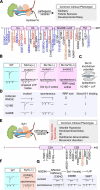Genetic disorders of neurotransmitter release machinery
- PMID: 37066095
- PMCID: PMC10102358
- DOI: 10.3389/fnsyn.2023.1148957
Genetic disorders of neurotransmitter release machinery
Abstract
Synaptic neurotransmitter release is an evolutionarily conserved process that mediates rapid information transfer between neurons as well as several peripheral tissues. Release of neurotransmitters are ensured by successive events such as synaptic vesicle docking and priming that prepare synaptic vesicles for rapid fusion. These events are orchestrated by interaction of different presynaptic proteins and are regulated by presynaptic calcium. Recent studies have identified various mutations in different components of neurotransmitter release machinery resulting in aberrant neurotransmitter release, which underlie a wide spectrum of psychiatric and neurological symptoms. Here, we review how these genetic alterations in different components of the core neurotransmitter release machinery affect the information transfer between neurons and how aberrant synaptic release affects nervous system function.
Keywords: Munc13; SNAP25; SNAREopathy; neurogenetic disorders; synapse; synaptobrevin; synaptotagmins; syntaxin.
Copyright © 2023 Uzay and Kavalali.
Conflict of interest statement
The authors declare that the research was conducted in the absence of any commercial or financial relationships that could be construed as a potential conflict of interest.
Figures




Similar articles
-
SNAP25 disease mutations change the energy landscape for synaptic exocytosis due to aberrant SNARE interactions.Elife. 2024 Feb 27;12:RP88619. doi: 10.7554/eLife.88619. Elife. 2024. PMID: 38411501 Free PMC article.
-
Disorders of synaptic vesicle fusion machinery.J Neurochem. 2021 Apr;157(2):130-164. doi: 10.1111/jnc.15181. Epub 2020 Oct 4. J Neurochem. 2021. PMID: 32916768 Review.
-
Physical link and functional coupling of presynaptic calcium channels and the synaptic vesicle docking/fusion machinery.J Bioenerg Biomembr. 1998 Aug;30(4):335-45. doi: 10.1023/a:1021985521748. J Bioenerg Biomembr. 1998. PMID: 9758330 Review.
-
Distinct Functions of Syntaxin-1 in Neuronal Maintenance, Synaptic Vesicle Docking, and Fusion in Mouse Neurons.J Neurosci. 2016 Jul 27;36(30):7911-24. doi: 10.1523/JNEUROSCI.1314-16.2016. J Neurosci. 2016. PMID: 27466336 Free PMC article.
-
Disentangling the Roles of RIM and Munc13 in Synaptic Vesicle Localization and Neurotransmission.J Neurosci. 2020 Dec 2;40(49):9372-9385. doi: 10.1523/JNEUROSCI.1922-20.2020. Epub 2020 Nov 2. J Neurosci. 2020. PMID: 33139401 Free PMC article.
Cited by
-
Native-state proteomics of Parvalbumin interneurons identifies unique molecular signatures and vulnerabilities to early Alzheimer's pathology.Nat Commun. 2024 Apr 1;15(1):2823. doi: 10.1038/s41467-024-47028-7. Nat Commun. 2024. PMID: 38561349 Free PMC article.
-
Copines, a Family of Calcium Sensor Proteins and Their Role in Brain Function.Biomolecules. 2024 Feb 21;14(3):255. doi: 10.3390/biom14030255. Biomolecules. 2024. PMID: 38540677 Free PMC article. Review.
-
Candidate Key Proteins of Tinnitus in the Auditory and Motor Systems of the Thalamus.Int J Mol Sci. 2025 Jun 17;26(12):5804. doi: 10.3390/ijms26125804. Int J Mol Sci. 2025. PMID: 40565265 Free PMC article.
-
The Relationship between SNAP25 and Some Common Human Neurological Syndromes.Curr Pharm Des. 2024;30(30):2378-2386. doi: 10.2174/0113816128305683240621060024. Curr Pharm Des. 2024. PMID: 38963116 Review.
-
Highly adaptable deep-learning platform for automated detection and analysis of vesicle exocytosis.Nat Commun. 2025 Jul 12;16(1):6450. doi: 10.1038/s41467-025-61579-3. Nat Commun. 2025. PMID: 40651941 Free PMC article.
References
Publication types
Grants and funding
LinkOut - more resources
Full Text Sources

